|
|
EASTER ISLAND: 14.09.- 23.09.2003
Translated by PROMT-Online-Translator
|
Route: Hanga Roa, Anakena, Tongariki, Rano Raraku, Orongo,
Vinapu, Puna Pau, Hanga Roa (mehr Örtlichkeiten gibt es quasi nicht)
Distance: about 100 Km Ascent:
may be 500m
|
| |
 Preface: Easter island, which belongs
to Chile, has the form of a triangle with the edge lengths of 24 km
x 20 km x 15 km and is therefore not really big. Because the island
has originated from volcanism, it is a little bit hilly. Though to
camping is not allowed officially, however I had no problem as I tried
to hide the tent a little bit. The inhabitants are very friendly and
helpful and many speak even English. The description of the history
and the culture of the Easter islands is partly different, by the
way, according to source. My descriptions is a mixture from Footprint-,
LAN Chile and national park guide so a few small mistakes may have
happened. Preface: Easter island, which belongs
to Chile, has the form of a triangle with the edge lengths of 24 km
x 20 km x 15 km and is therefore not really big. Because the island
has originated from volcanism, it is a little bit hilly. Though to
camping is not allowed officially, however I had no problem as I tried
to hide the tent a little bit. The inhabitants are very friendly and
helpful and many speak even English. The description of the history
and the culture of the Easter islands is partly different, by the
way, according to source. My descriptions is a mixture from Footprint-,
LAN Chile and national park guide so a few small mistakes may have
happened. |
| |
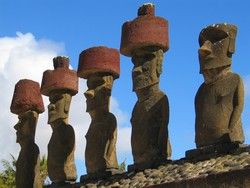 Settlement and discovery: Rapa
Nui, as the Easter Island is called by the locals, was presumably
settled about 800 A.D. by the Polynesians, and not like Thor Heyerdahl,
after his journey with the Kon Tiki in 1955, stated, from South America.
As the first Europeans the Dutch admiral Jacob Roggeven came in 1722
to the small island which lies 3700 km west of Chile and 4050 km to
the east of Tahiti, in the middle of the south Pacific. Admiral Roggeven
reached Rapa Nui on Easter Sunday, and named the island hence Easter
Island. Then in 1774 came captain James Cook to Easter Island and
then, finally, in 1786 the French also came. In 1888 Easter Island
was taken from Chile I do not know at all exactly whether it is called
now "Easter island" or "Easter islands", because
the main island "Rapa Nui" has three offshore mini-islets,
so-called Motus (one is even only one rock tower) on which merely
a few birds nest (see photo with the bird's man cult). Settlement and discovery: Rapa
Nui, as the Easter Island is called by the locals, was presumably
settled about 800 A.D. by the Polynesians, and not like Thor Heyerdahl,
after his journey with the Kon Tiki in 1955, stated, from South America.
As the first Europeans the Dutch admiral Jacob Roggeven came in 1722
to the small island which lies 3700 km west of Chile and 4050 km to
the east of Tahiti, in the middle of the south Pacific. Admiral Roggeven
reached Rapa Nui on Easter Sunday, and named the island hence Easter
Island. Then in 1774 came captain James Cook to Easter Island and
then, finally, in 1786 the French also came. In 1888 Easter Island
was taken from Chile I do not know at all exactly whether it is called
now "Easter island" or "Easter islands", because
the main island "Rapa Nui" has three offshore mini-islets,
so-called Motus (one is even only one rock tower) on which merely
a few birds nest (see photo with the bird's man cult). |
| |
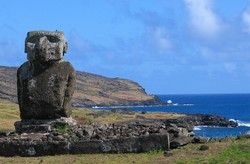 Moai: The Easter island is famous of course because
of the Moai, to the up to 9-m-high stone figures (LAN Chile speaks
of up to 21-m-high and the up to 300 tons heavy Moai) which were installed
around the whole island. In total there are about 600 of the Moai.
The Moai were installed with the back to the sea on old ares (Ahu)
and look thus with the face in the inland. The Moai served of 5 clans
which bult them around the island for religious admiration as well
as to express their strength. Moai: The Easter island is famous of course because
of the Moai, to the up to 9-m-high stone figures (LAN Chile speaks
of up to 21-m-high and the up to 300 tons heavy Moai) which were installed
around the whole island. In total there are about 600 of the Moai.
The Moai were installed with the back to the sea on old ares (Ahu)
and look thus with the face in the inland. The Moai served of 5 clans
which bult them around the island for religious admiration as well
as to express their strength. |
| |
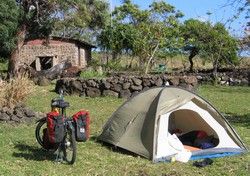 Camping on the Easter island part
I: According to guidebook there should be a free campground in
Anakena and Rano Raraku. Directly after arrival on the Easter island
I exchanged money, bought a lot of food and cycled to the other end
of the island to Anakena. The souvenir shop assistants sitting there
believed that I can build up here everywhere easily my tent and one
of the ladies collected in a neighbouring building also immediately
0.8€ of me (I thought this would be for camping and the use of
the sanitary facilities). I had built up just my tent when a park
ranger on his horse came riding towards me and explained me in Spanish
that here camping would be forbidden. Then I explained to him in English
that that the nice lady from the souvenier stand had already collected
money of me. Then, however, at last he offered to me that I may build
up my tent, nevertheless, a night in the ranger station. Said done
and thus I packed my bike again to pitch the tent only about 300 m
farther. Fernando. the ranger. if is, by the way, a rather nice fellow
and shortly before close he came again to me for a small chat. His
English as well as my Spanish had considerably become better in the
interim and thus I told him about my trip. Camping on the Easter island part
I: According to guidebook there should be a free campground in
Anakena and Rano Raraku. Directly after arrival on the Easter island
I exchanged money, bought a lot of food and cycled to the other end
of the island to Anakena. The souvenir shop assistants sitting there
believed that I can build up here everywhere easily my tent and one
of the ladies collected in a neighbouring building also immediately
0.8€ of me (I thought this would be for camping and the use of
the sanitary facilities). I had built up just my tent when a park
ranger on his horse came riding towards me and explained me in Spanish
that here camping would be forbidden. Then I explained to him in English
that that the nice lady from the souvenier stand had already collected
money of me. Then, however, at last he offered to me that I may build
up my tent, nevertheless, a night in the ranger station. Said done
and thus I packed my bike again to pitch the tent only about 300 m
farther. Fernando. the ranger. if is, by the way, a rather nice fellow
and shortly before close he came again to me for a small chat. His
English as well as my Spanish had considerably become better in the
interim and thus I told him about my trip. |
| |
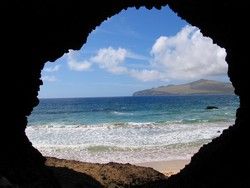 Cave in the Ovahe beach: This
wonderful small cave lies at the Ovahe beach, a small beach with "slightly"
pink-coloured sand in the north of Rapa Nui. Cave in the Ovahe beach: This
wonderful small cave lies at the Ovahe beach, a small beach with "slightly"
pink-coloured sand in the north of Rapa Nui. |
| |
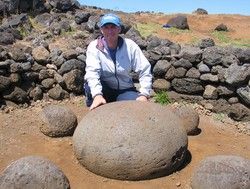 The navel of the world: The round
stone in the middle with his four "guards" is called by
local "Te Pito Kura" what is called so much like "navel
of the world". The navel of the world: The round
stone in the middle with his four "guards" is called by
local "Te Pito Kura" what is called so much like "navel
of the world". |
| |
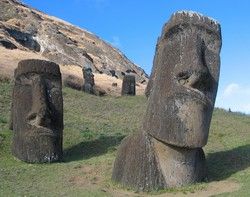 Birth of the Moai: Here in the stone quarries
in the Ranu Raraku volcano is where the Moai are carved out of the
rocks. Afterwards the Moais were rolled on wooden trunks over the
island to their destination. Finally the production and the transport
became too expensive. Birth of the Moai: Here in the stone quarries
in the Ranu Raraku volcano is where the Moai are carved out of the
rocks. Afterwards the Moais were rolled on wooden trunks over the
island to their destination. Finally the production and the transport
became too expensive. |
| |
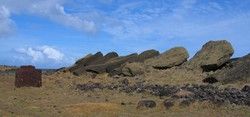 Death of the Moai: Over the centuries the
population of Rapa Nui has always grown and in the 16th and 17th century
the population had already risen to 4000 inhabitants what has presumably
brought some ecological problems with itself on the small island and
has led thus to some wars between the tribes. During these wars the
Moai, production was reduced due to cost reasons and wooden shortage
which already became obvious in the 14th century, were totally opposed.
Further all Moai were tipped over and the altars were destroyed. Some
of the Moai, like here in Anakena, were installed this century, again
to give a better insight into the old culture to the tourists. Today
about 2800 inhabitants live on Rapa Nui live. Death of the Moai: Over the centuries the
population of Rapa Nui has always grown and in the 16th and 17th century
the population had already risen to 4000 inhabitants what has presumably
brought some ecological problems with itself on the small island and
has led thus to some wars between the tribes. During these wars the
Moai, production was reduced due to cost reasons and wooden shortage
which already became obvious in the 14th century, were totally opposed.
Further all Moai were tipped over and the altars were destroyed. Some
of the Moai, like here in Anakena, were installed this century, again
to give a better insight into the old culture to the tourists. Today
about 2800 inhabitants live on Rapa Nui live. |
| |
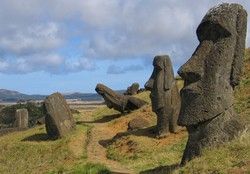 Moai at Ranu Raraku: With the
wars also there came the end of the Moai and it looks almost in such
a way that the people who made them dropped their tools in the middle
of the work, because everywhere are to be found here Moai in the most
different stadia of production. A total of about 100 virtually ready
Moai lie here scattered at the foot of Ranu Raraku. Moai at Ranu Raraku: With the
wars also there came the end of the Moai and it looks almost in such
a way that the people who made them dropped their tools in the middle
of the work, because everywhere are to be found here Moai in the most
different stadia of production. A total of about 100 virtually ready
Moai lie here scattered at the foot of Ranu Raraku. |
| |
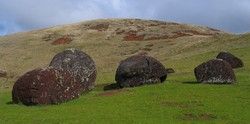 Hat factory: All hats came from the crater
of the volcano Puna Pau. As well as already the Moai factory the "hat
factory" was simply left so also during the family wars. Hat factory: All hats came from the crater
of the volcano Puna Pau. As well as already the Moai factory the "hat
factory" was simply left so also during the family wars. |
| |
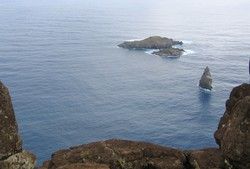 "Birdman" cult: After the wars
the majority of the inhabitants lived in Hanga Roa and after the Moai
were tipped over and the altars were destroyed they developed a new
possibility to express the tensions between the tribes: the "birdman"
- cult. Every spring there was among the leaders of the clans, or
a representative, a big competition for the first egg which was laid
by the Manatara, a sea bird, on Motu Nui, the biggest of three offshore
islets. The participants had to swim to the island and remained there
so long , several days or even weeks, until one had found the first
egg and had brought to Orongo. The man who brought back the "holy"
egg was called the "birdman" for the next year and brought
his clan and himself big honour. About the role them the bird's man
in the everyday life of the inhabitants on Rapa Nui played, unfortunately,
I could find out nothing. The last competition was carried out in
1867. "Birdman" cult: After the wars
the majority of the inhabitants lived in Hanga Roa and after the Moai
were tipped over and the altars were destroyed they developed a new
possibility to express the tensions between the tribes: the "birdman"
- cult. Every spring there was among the leaders of the clans, or
a representative, a big competition for the first egg which was laid
by the Manatara, a sea bird, on Motu Nui, the biggest of three offshore
islets. The participants had to swim to the island and remained there
so long , several days or even weeks, until one had found the first
egg and had brought to Orongo. The man who brought back the "holy"
egg was called the "birdman" for the next year and brought
his clan and himself big honour. About the role them the bird's man
in the everyday life of the inhabitants on Rapa Nui played, unfortunately,
I could find out nothing. The last competition was carried out in
1867. |
| |
 Orongo: Orongo, the ceremonial place high on top on
the crater edge of the Ranu Chewing volcano, was established specially
for the realisation of the bird's man competition. In a specially
separated area the priests who were responsible for the realisation
of the competition were accommodated. From the "balcony"
of their house the priests had in view of the island Motu Nui fully
(the photo "birdman" cult is shot from here) and could follow
thus the hair-raising descent of the crater edge down to the sea as
well as the afterwards swimming stage to the island from the first
row. Orongo: Orongo, the ceremonial place high on top on
the crater edge of the Ranu Chewing volcano, was established specially
for the realisation of the bird's man competition. In a specially
separated area the priests who were responsible for the realisation
of the competition were accommodated. From the "balcony"
of their house the priests had in view of the island Motu Nui fully
(the photo "birdman" cult is shot from here) and could follow
thus the hair-raising descent of the crater edge down to the sea as
well as the afterwards swimming stage to the island from the first
row. |
| |
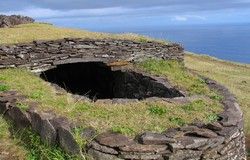 Stone houses in Orongo: Although inhabit
only for a few weeks during the realisation of the bird's man competition,
the houses were extremely respectable in Orongo. The houses existed
of a long oval room in each case with thick double-walled stone walls
which were filled with earth. The walls as well as the roofs were
built from basalt slices. Then for the conclusion the roofs were still
covered with grass. Although they were built very solidly, up here
the houses were put out on the volcano crater, nevertheless, the strong
Pacific winds were tough on the hoses and thus maintenance operations
were necessary permanently. Stone houses in Orongo: Although inhabit
only for a few weeks during the realisation of the bird's man competition,
the houses were extremely respectable in Orongo. The houses existed
of a long oval room in each case with thick double-walled stone walls
which were filled with earth. The walls as well as the roofs were
built from basalt slices. Then for the conclusion the roofs were still
covered with grass. Although they were built very solidly, up here
the houses were put out on the volcano crater, nevertheless, the strong
Pacific winds were tough on the hoses and thus maintenance operations
were necessary permanently. |
| |
 Ahu Tongariki: After the coup during the
wars in the 17th century. the Moai in Tongariki suffered another stroke
of fate. In 1960 the Moai were washed by a tidal wave, released by
an earthquake, of their platform. Thanks to Japanese money and local
virility (construction crane according to photo in Tongariki and historical
method run LAN brochure), the Moai were put again on their platforms.
Once with his 15 Moai Ahu Tongariki was the biggest platform on the
Easter islands. Ahu Tongariki: After the coup during the
wars in the 17th century. the Moai in Tongariki suffered another stroke
of fate. In 1960 the Moai were washed by a tidal wave, released by
an earthquake, of their platform. Thanks to Japanese money and local
virility (construction crane according to photo in Tongariki and historical
method run LAN brochure), the Moai were put again on their platforms.
Once with his 15 Moai Ahu Tongariki was the biggest platform on the
Easter islands. |
| |
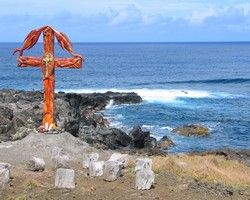 Church by the sea: The Open air church
with a few round chunks of wood directly by the sea is also not bad.
In the evaluation "beauty with low building cost" she has
one of the front places! Church by the sea: The Open air church
with a few round chunks of wood directly by the sea is also not bad.
In the evaluation "beauty with low building cost" she has
one of the front places! |
| |
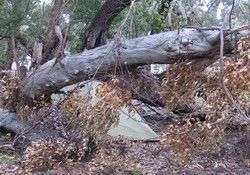 Camping on the Easter island part
II: After camping in the national park was not allowed, I had
to hide during the next days then of course again in the bushes! Here
because of rain weather I remained a total of 3 nights in this place. Camping on the Easter island part
II: After camping in the national park was not allowed, I had
to hide during the next days then of course again in the bushes! Here
because of rain weather I remained a total of 3 nights in this place.
|
| |
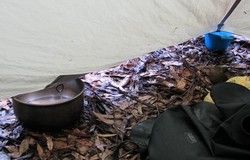 Rainwater: Normally if it rains in the
morning already before departure Nadine and I exclaima rainy day,
what means that we stay so long in the tent, until the rain has stopped
again. The only thing which limited us, was the fact that we had sometime
no more water (food we normally have always enough). Now there it
has taken more than 3 years and the tip of an American on Tahiti,
until I have got finally the idea, that one can collect easily the
rainwater from the tent! Within 2 hours I had collected so much rainwater
that it managed to wash me and my laundry (we both urgently needed)
and to fill still about 6 litres in my water bag! Allowedly I was
quite occupied to coordinated all my containers. Rainwater: Normally if it rains in the
morning already before departure Nadine and I exclaima rainy day,
what means that we stay so long in the tent, until the rain has stopped
again. The only thing which limited us, was the fact that we had sometime
no more water (food we normally have always enough). Now there it
has taken more than 3 years and the tip of an American on Tahiti,
until I have got finally the idea, that one can collect easily the
rainwater from the tent! Within 2 hours I had collected so much rainwater
that it managed to wash me and my laundry (we both urgently needed)
and to fill still about 6 litres in my water bag! Allowedly I was
quite occupied to coordinated all my containers. |
| |
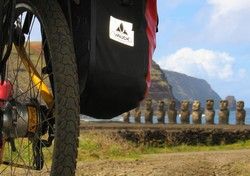 Photo of the bike: Of course I also wanted
to take a photo with the Moai, however, unfortunately, they are blocked
off. Then luckily I have found a gravel road from which one could
look from above into the Moai. In total I have tried to gain control
during at least 1 1/2 hours on the ground with countless photos of
different sharpness and exposure (either Moai sharply and brightly
and, besides, wheel blurred and darkly or vice versa) more or less. Photo of the bike: Of course I also wanted
to take a photo with the Moai, however, unfortunately, they are blocked
off. Then luckily I have found a gravel road from which one could
look from above into the Moai. In total I have tried to gain control
during at least 1 1/2 hours on the ground with countless photos of
different sharpness and exposure (either Moai sharply and brightly
and, besides, wheel blurred and darkly or vice versa) more or less.
|
| |
 Blossoming bush: Everywhere on the Easter
Island blossoms this marvellous bush which has also very sharp thorns. Blossoming bush: Everywhere on the Easter
Island blossoms this marvellous bush which has also very sharp thorns. |
| |
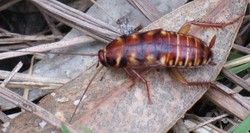 Cockroaches: Till present in my youthful
carelessness I have always thought that cockroaches live in baking
rooms, canteen kitchens and cheap hotels and was surprised therefore
a little bit to find them here on Easter Island all at once in the
woods. However, somewhere they must have lived of course, before the
people with their modern civilisation have overgrown the world (however:
in the woods on Easter Island!?). It is quite unbelievable as fast
the cockroaches sniff food in the air. Hardly I had unpacked some
food they already came and were shy by no means. I have discovered
here, by the way, 2 kinds of cockroaches: the "normal ones"
they are relatively small here and "big coloured ones" (hope
the coloured one is really a cockroach). Cockroaches: Till present in my youthful
carelessness I have always thought that cockroaches live in baking
rooms, canteen kitchens and cheap hotels and was surprised therefore
a little bit to find them here on Easter Island all at once in the
woods. However, somewhere they must have lived of course, before the
people with their modern civilisation have overgrown the world (however:
in the woods on Easter Island!?). It is quite unbelievable as fast
the cockroaches sniff food in the air. Hardly I had unpacked some
food they already came and were shy by no means. I have discovered
here, by the way, 2 kinds of cockroaches: the "normal ones"
they are relatively small here and "big coloured ones" (hope
the coloured one is really a cockroach). |
| |
 Photo of the bike II: Then, finally, in
Hanga Roa I had the possibility to get near to a Moai. Photo of the bike II: Then, finally, in
Hanga Roa I had the possibility to get near to a Moai. |
| |
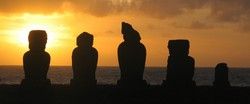 Sunset: Now after 10 days on this small,
but culturally and humanely very nice island I´flying now to
the mainland of Chile. Sunset: Now after 10 days on this small,
but culturally and humanely very nice island I´flying now to
the mainland of Chile. |
| |
|
|
I
BOOKLET
available
for
DONATION!

50pages, 80 b/w photos, background
infos, stories, ...
Just send your donation
to our
Pay
Pal account: nadinepuschkasch@yahoo.de
and email us your post
address and we´ll send it to you.
|
| |
| |
|
Like to place your Ad here?
Just e-mail to:
martinlunz@yahoo.de
|
| |
| |
|
You
liked our website and like to contribute?
Our Pay
Pal account is: nadinepuschkasch@yahoo.de
|
|
| |
|
